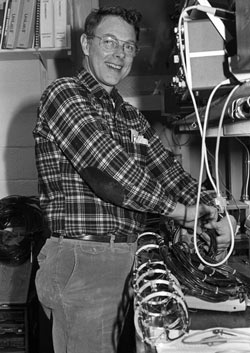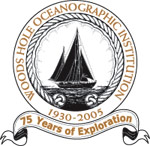This is an archived site. This site is no longer being maintained or reviewed for broken links.
Employee Portrait Gallery—Sandy Williams
 |
|
|
Sandy Williams assembles a Benthic Acoustic Stress Sensor (BASS) current meter at his lab bench. (Photo by Terri Corbett) |
Sandy Williams carries a small pack of tools whenever he travels — a few Allen wrenches that fit in his wallet, small screwdrivers, a few other items. This allows him to fix things when—and where—they break. Not only can Sandy fix most machines, instruments, and devices, he also explains with great clarity and unbounded enthusiasm how the item should work, why it doesn’t, and how to repair it. His own life work is about making accurate and precise measurements of oceanic phenomena, and he approaches it with the same delight.
Albert J. Williams 3rd arrived at WHOI in 1969 as a postdoc with a Ph.D. in experimental physics from Johns Hopkins University. “I came here because I was interested in making measurements,” he says. “I wanted things I could touch, and earth measurements were appealing.”
He quickly became involved with projects that have lasted throughout his career. Salt fingers in the ocean were a major early research focus: When small volumes of water become cooler and saltier than surrounding water, they sink, poking fingerlike into deeper layers. Sandy was the first to show that this previously hypothesized ocean mixing process actually existed by building an optical device that successfully captured images of salt fingers in the Mediterranean Sea outflow. The novel instruments he has designed and built include the widely-used Benthic Acoustic Stress Sensor (BASS) current meter, described as “offering unparalleled current measurement accuracy.” Another is a relatively inexpensive “beer-can” sized velocity sensor whose prototype was in a Coors can.
Sandy served as chairman of the Applied Ocean Physics and Engineering Department from 1987 to 1992. Over the years he has mentored many students, including those in the Joint Program, summer student fellows, and local high school science fair participants. He designed and taught the MIT/WHOI Joint Program’s Oceanographic Instruments Systems graduate course from 1985 to 2004.
“I’ve worked hard and I’ve been lucky,” Sandy says “I’ve tackled fascinating problems in both coastal waters and the deep sea. Woods Hole is a magic place, where scientists and engineers work together, with low thresholds between departments, and the ocean outside the door.”
Though he became a Scientist Emeritus in 2003, Sandy hasn’t missed a beat, working in his lab most days when he isn’t off visiting World Heritage and other sites with his wife Izzie. He is active in the Institute of Electrical and Electronics Engineers, which named him a Fellow in 2005. He is an advisor to the Group on Earth Observation on tsunami measurements, and he participated in two Antarctic research cruises (in 2001 and 2004), with a third planned for February 2006. During the second trip he was pleased to be one of four scuba divers participating in a “drift” dive across the Antarctic Circle. He continues to build current meters and collaborate with other WHOI scientists. “When I retired, I could do anything I wanted, and I’m doing the same things anyway,” he says. “What more proof could there be that I chose a great career and the right place for it?”
[back]

